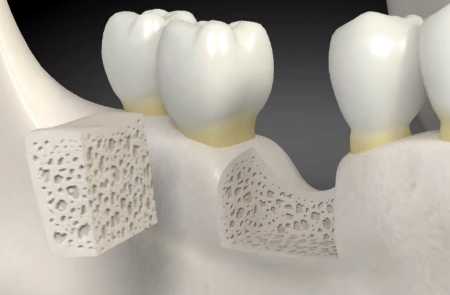Bone grafting or osteoplasty is an operation to restore the level/volume of bone sufficient for a dental implant. The need for this surgery occurs when there is atrophy of bone tissue. In the classical dental implantation technique, bone grafting operations are performed very frequently.
Jaw Bone Grafting Overview
In addition to implantological tasks, osteoplasty can be indicated for the restoration of bone tissue after traumatic injuries and for the treatment of periodontitis in cases of severe bone atrophy.
Today there is a variety of different materials and techniques for the restoration of the level and volume of bone.
There is a “traditional” classification of materials used for this type of surgery:
- Autogenous (material is taken directly from the patient).
- Allogenic (another person acts as a donor).
- Xenogenic (biological material is taken from an animal).
- Alloplastic (artificial/synthetic material).
How Bone Grafting Works in Dentistry
In practice, mainly two categories of materials are widely used and well-proven: autologous and alloplastic.
Many dental surgeons recommend reconstructing the bone with bone fragments taken from the patient. Such surgery is sometimes referred to as bone block grafting. “Schematically speaking, the essence of the operation with bone fragments is as follows: the surgeon cuts out the necessary volume and shape of the block (“donor site” is determined individually according to diagnostic data), places it in the area where bone augmentation is required, fixes the block (the doctor can use titanium screws and surgical membranes for fixation); then the intervention sites are closed with mucosa and sutures are applied.
Working with bone blocks taken from the patient, surgeons often refer to operations with predictably good, in most cases, results. The decisive thing here is the main property of the material: it is well “known” to the body, so correct and successful engraftment is quite expected.
Disadvantages of Bone Grafting
Some disadvantages of grafting bone blocks:
- The level of intervention is larger and the operation more complicated, as a consequence – a higher level of postoperative discomfort (but if you follow all the recommendations and prescriptions of the doctor, the level of discomfort and risk of complications is reduced to a minimum).
- The fact that the surgery is more complicated also affects the price of the service.
Cost of Bone Grafting
The cost of a jaw bone graft is formed for each transplant separately. That is, if the surgery requires 5 bone grafts, the cost will be the sum of each of the 5 grafts performed. Going back to the price question, each graft costs in 2024 anywhere from $200 to $1,300 in the United States (depending on the difficulty) for each transplant.
What Else You Should Know
If the situation allows, the doctor may use a synthetic material. You can meet such names as “bone chips” or “bone fiber” (due to the similarity of the material in structure).
Such material is also used to form the desired volume and level of bone tissue (the doctor uses a surgical membrane to fix it). Strictly speaking, the artificial material is not a bone replacement, it is a substance that promotes bone growth. If the body needs to “grow” a bone block to the existing bone, in the case of artificial materials, the body needs to “grow” the bone to the volume outlined during osteoplasty (and the material itself creates the necessary conditions for this).
The level of intervention in the case of such a technique is less here, but the key is due to the fact that the material is artificial. Accordingly, predicting results is more difficult. Synthetic materials vary in composition and properties, and the doctor needs to consider all the nuances in order to make an accurate choice.

